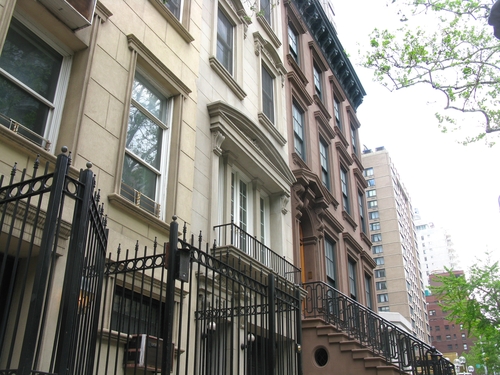|
Getting your Trinity Audio player ready...
|
Edited by: TJVNews.com
Owning a townhouse in New York City has historically been regarded as the pinnacle of status and prestige, placing individuals in the esteemed company of the city’s elite, reminiscent of the Rockefellers, Carnegies, Fricks, Vanderbilts, and others, as was noted in a recently published report in The New York Post. However, recent shifts in societal dynamics and concerns surrounding safety have begun to reshape perceptions of these iconic dwellings.
In a city where public safety has become a pressing concern for many residents, the allure of townhouse living is starting to wane. According to a poll conducted by the Citizens Budget Commission, only 37% of New Yorkers rated public safety in their neighborhoods as excellent or good, a notable decrease from 50% just six years prior, the Post report indicated. This decline in safety, coupled with issues such as the migrant crisis and squatters, has led some affluent denizens to reevaluate their residential choices.
Marzena Wawrzaszek, a seasoned real estate broker with SERHANT, provided valuable insights into the shifting dynamics of New York City’s housing market when she spoke with the Post. She noted a significant decline in contracts for townhouses, with a staggering 22% decrease recorded at the end of 2023, compared to a mere 5% decline in new developments during the same period. Wawrzaszek attributes this trend to a changing mindset among potential buyers.
The onset of the COVID-19 pandemic initially sparked a surge in demand for townhouses, driven by desires for minimal contact and enhanced privacy. However, as the city navigated through various phases of the pandemic, preferences evolved. As per the Post report, Wawrzaszek observed a notable shift away from townhouses towards doorman buildings, as safety and security take precedence in the minds of discerning buyers.
Illustrating this trend, Wawrzaszek recounted for the Post, the experiences of her clients. A West Village couple, once enamored with the charm of their townhouse, ultimately decided to sell their property and relocate to a new development in the Financial District due to security concerns, according to the information provided in the Post report. Similarly, a family of four withdrew from a $3 million townhouse deal in Williamsburg last summer, citing similar apprehensions. They chose to invest in a new development on the Upper West Side equipped with a doorman.
Within social media forums like the Moms of the Upper East Side Facebook group, inquiries about the safety of townhouses have become recurrent themes. The Post report indicated that concerned mothers expressed reluctance to consider townhouse living without assurances of security measures in place. The prevailing sentiment reflects a broader apprehension permeating through affluent communities.
Herman Weisberg, a former NYPD detective now heading the Sage Intelligence Group, echoes these sentiments, citing an increase in townhouse owners seeking security consultation. Speaking to the Post, he recounted a disconcerting reality faced by residents of picturesque neighborhoods, where scenes of drug use and vagrancy tarnish the once-idyllic streets. Weisberg’s observations paint a stark picture of urban decay encroaching upon traditionally upscale enclaves, compelling homeowners to take proactive measures for their safety.
In the face of these challenges, Weisberg dispelled any notion of reliance solely on law enforcement, as was noted in the Post report. The shifting landscape of urban security demands a multifaceted approach, one that empowers homeowners to safeguard their residences and communities proactively.
For townhouse owners, the imperative to secure their residences has never been more pressing. Weisberg revealed to the Post that some clients are investing upwards of $50,000 in security upgrades, ranging from reinforced doors and windows to advanced surveillance systems. According to the Post report, these expenditures, while necessary for safeguarding against potential threats, can prove especially burdensome in historic homes and districts where preservation regulations may impose additional constraints.
Moreover, the ultra-wealthy are resorting to even more elaborate security measures to ensure their safety. The Post reported that some are willing to shell out $100 per hour for round-the-clock, plainclothes surveillance—a testament to the lengths individuals are willing to go to maintain a sense of security. Others opt to pool resources with neighbors, forming collective security arrangements to fortify entire blocks or communities.
From collaborative initiatives to discreet panic rooms, affluent homeowners are investing in high-end security measures to fortify their residences against potential threats.
For those seeking the ultimate in high-end security, the advent of panic rooms represents the pinnacle of protection. Weisberg spoke to the Post about a surge in demand for these fortified sanctuaries, particularly since the onset of the COVID-19 pandemic. Designed to blend seamlessly into the home’s aesthetic, panic rooms exude an air of sophistication, masquerading as ordinary offices or study spaces. Yet, beneath the veneer of normalcy lies a meticulously reinforced stronghold, equipped with state-of-the-art security features such as secondary communication systems and Tesla-like battery packs.
Remarkably, opinions on panic rooms diverge among Weisberg’s clientele. While some relish the opportunity to showcase their fortified sanctuaries to guests, others prefer utmost discretion, opting for stealthy concealment to preserve the illusion of normalcy, the Post report detailed. This divide underscores a nuanced understanding of security among affluent homeowners, with some prioritizing ostentatious displays of protection while others prioritize subtlety and discretion.




